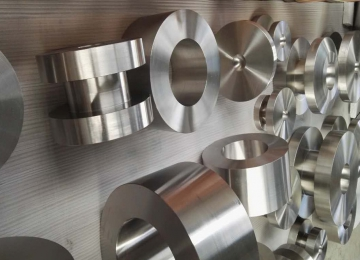
TA15 is a titanium alloy whose composition is Ti-6.5Al-2Zr-1Mo-1V. The main strengthening mechanism of this alloy is solid solution strengthening through the α-stabilizing element Al. Adding neutral element Zr and β-stabilizing elements Mo and V can improve its processability. Since its Al equivalent is 6.58% and Mo equivalent is 2.46%, TA15 is a near-alpha titanium alloy with high Al equivalent. This makes TA15 not only have good thermal strength and weldability of α-type titanium alloy, but also have process plasticity close to α-β type titanium alloy. TA15 alloy has medium strength at room temperature and high temperature, and has good thermal stability and welding performance, but its process plasticity is slightly lower than TC4.
TA15 chemical element content (%)
Material | TA15 | ||||||||||
chemical composition | Fe | C | Si | Mo | N | V | Zr | Al | H | O | Ti: |
≦0.25 | ≦0.08 | ≦0.15 | 0.5-2 | ≦0.05 | 0.8-2.5 | 1.5-2.5 | 5.5-7.1 | ≦0.015 | ≦0.15 | margin | |
Heat treatment system of TA15 titanium alloy
The heat treatment system of TA15 titanium alloy includes the following two types:
1) Annealing: Heat TA15 titanium alloy to 700-800°C, hold for 15-60 minutes, and then cool naturally. For bars, forgings, die forgings, thick-walled profiles and their parts, the annealing temperature is 700-850°C, the holding time is 1-4 hours, and then cooled naturally.
2) Stress relief annealing: Heat the TA15 titanium alloy to 600-650°C, hold the temperature for 0.5-8 hours, and then cool naturally. This heat treatment method is mainly used to reduce the internal stress of the material and improve its mechanical properties and stability.
Smelting and casting process of TA15 titanium alloy
The smelting and casting process of TA15 titanium alloy is as follows:
1) Smelting: TA15 titanium alloy should be smelted in three vacuum consumable electrode arc furnaces. This smelting method can effectively remove impurities and oxides and improve the purity and uniformity of the alloy.
2) Casting: The casting of TA15 titanium alloy uses a vacuum consumable electrode arc solidification furnace. In this furnace, the alloy is melted under vacuum and cast into shape. Since the content of gas and impurities is very low in a vacuum environment, the occurrence of defects such as pores and inclusions can be effectively avoided. In addition, the solidification speed in a vacuum environment is faster, fine grains and uniform organizational structure can be obtained, and the mechanical properties and corrosion resistance of castings can be improved.
Welding performance of TA15 titanium alloy
The welding performance of TA15 titanium alloy is good, and its welding behavior is basically similar to α alloy. The following are the welding performance characteristics of TA15 titanium alloy:
1) Stabilization annealing is not necessary after welding.
2) The strength of the martensitic α phase of the alloy is close to the strength of the α phase.
3) The welding performance of argon arc welding, contact welding and submerged arc welding is good.
4) The room temperature strength and high temperature strength of the weld are 90%-95% of the strength of the base metal.
5) The automatic argon arc welding joints of 2mm thick plates have little difference in strength, bending angle and impact performance in the welding state, post-weld annealing state, and post-weld heat exposure state of 450°C for 100 hours. The joints are not sensitive to heat treatment.
Application overview and special requirements of TA15 titanium alloy
TA15 titanium alloy is a titanium alloy with high strength, high toughness and good corrosion resistance, so it is widely used in aerospace, shipbuilding, chemical industry, medical and other fields. The following is the application overview and special requirements of TA15 titanium alloy:
1) Application overview: TA15 titanium alloy has been widely used in manufacturing aircraft and engine load-bearing structural parts, especially welded load-bearing components. In addition, it is also used to manufacture parts in ships, chemical equipment, medical equipment and other fields.
2) Special requirements:
When designing parts, general principles for the design of titanium alloy parts should be considered. For example, when used in general climate environments, additional surface protection is not required.
Contact with stainless steel and nickel-based alloys without protection is allowed under marine climate conditions.
When the operating temperature is higher than 300°C, protective coatings should be used or the working life should be limited.
Reasonable and effective protective measures must be taken for parts in direct contact with aluminum alloy and structural steel.
For titanium alloy parts with relative motion, in order to prevent fretting corrosion, an isolation coating should be used.
Try to avoid assembling titanium alloy parts with cadmium-plated steel parts.
In general, TA15 titanium alloy needs to consider some special requirements when applying to ensure its performance and service life.

